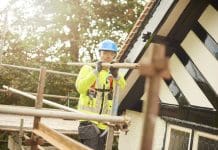Building accessibility is covered by Approved Document M, yet many projects still suffer from avoidable errors and poor choices that can be costly to put right. Ian Streets of About Access examines the problem
From fancy – but flawed – design features to basic building accessibility errors, we’re surprised and disappointed to see so many projects that require remedial work.
Recent examples have come from assessing accessibility of museums. If we were to open a museum of design howlers, these examples would probably be in it.
The first site looked fine as we approached, with a gently sloping footpath leading to the main doors, and the alternative of a few steps with the correct nosings and appropriate handrails.
But unfortunately, the handrails protruded part of the way across the path, which was also obstructed, albeit temporarily, by a carelessly located A-board. The glass doors carried poor manifestation, creating difficulties for anyone with a visual impairment, and they opened outwards, leaving visitors cramped for space.
The push pad to operate the doors was fixed to a wall at the side but behind a barrier, as was the proximity card reader used by staff. Both were therefore almost impossible for a wheelchair user to reach.
Inside the building, there is an accessible WC on each level but they all have the same transfer direction. Some people prefer or need right transfer and some people use left transfer, so why not alternate them on the different floors?
The main access to the second building is via a revolving glass door, which cannot be used by wheelchair users and which also presents problems for some people with other impairments; for example, you would not be able to use it with an assistance dog.
There is a pass door, which is operated by a push pad, but when we visited the pad was obstructed by an A-board. Anyone who could still operate the door would then find it opens outwards, leaving little space to get around the door and into the building.
The manifestation on the revolving door and the pass door is inadequate, and the amount of glass used in the design and construction makes it difficult for some people to define key features of the door.
The signage on the loo doors is a modern design but lacks clarity. You can only work out which is the men’s loo when you compare the sign with the one for the ladies’ loo. Many disabled people are capable of using non-disabled loos, but not when the signage is so confusing.
On the staircase, the handrail is recessed into the wall. It looks nice and stylish but is guilty of form over function. It just doesn’t do the job. If someone needs to take support from the handrail when they use the stairs, they will not be able to do it with this design.
There are other design features that, at best, confuse people, such as a full-length mirror at the back of the lift. It is essential to have a mirror to enable wheelchair users to see if there are any obstructions behind them, such as someone coming into the lift, and to identify which floor they are on. But it should only cover the top half of the wall of the lift; a full-length mirror is confusing.
All of these issues are addressed in Approved Document Part M and therefore raise questions about the part played by the designers and by Building Control.
The client is unlikely to understand building accessibility so will go to a professional, expecting the design to meet the required standards. It’s up to the designer to ensure their work does that, enabling Building Control to sign it off. Alternatively, the designer should produce an access strategy to say why a feature doesn’t meet the guidance and it is then up to Building Control to decide whether that is acceptable.
The examples we have highlighted are as basic as it gets. Setting the handrail into the wall will have cost more money than fixing it to an accessible position on the side of the wall. In common with the other scenarios, it demonstrates cases of spending more money than necessary on the original features, and then having to spend again on modifications to make the buildings properly accessible.
Ian Streets
About Access Limited
Tel: 01482 651101




![[VIDEO] UK-based firm reveals ‘world’s first’ fully AI-driven architectural project Studio Tim Fu has revealed the 'world's first' fully AI-driven architectural project in Slovenia, developing six luxury villas on the Lake Bled Estate](https://www.pbctoday.co.uk/news/wp-content/uploads/2025/03/Interior-1-studio-tim-fu-218x150.gif)









